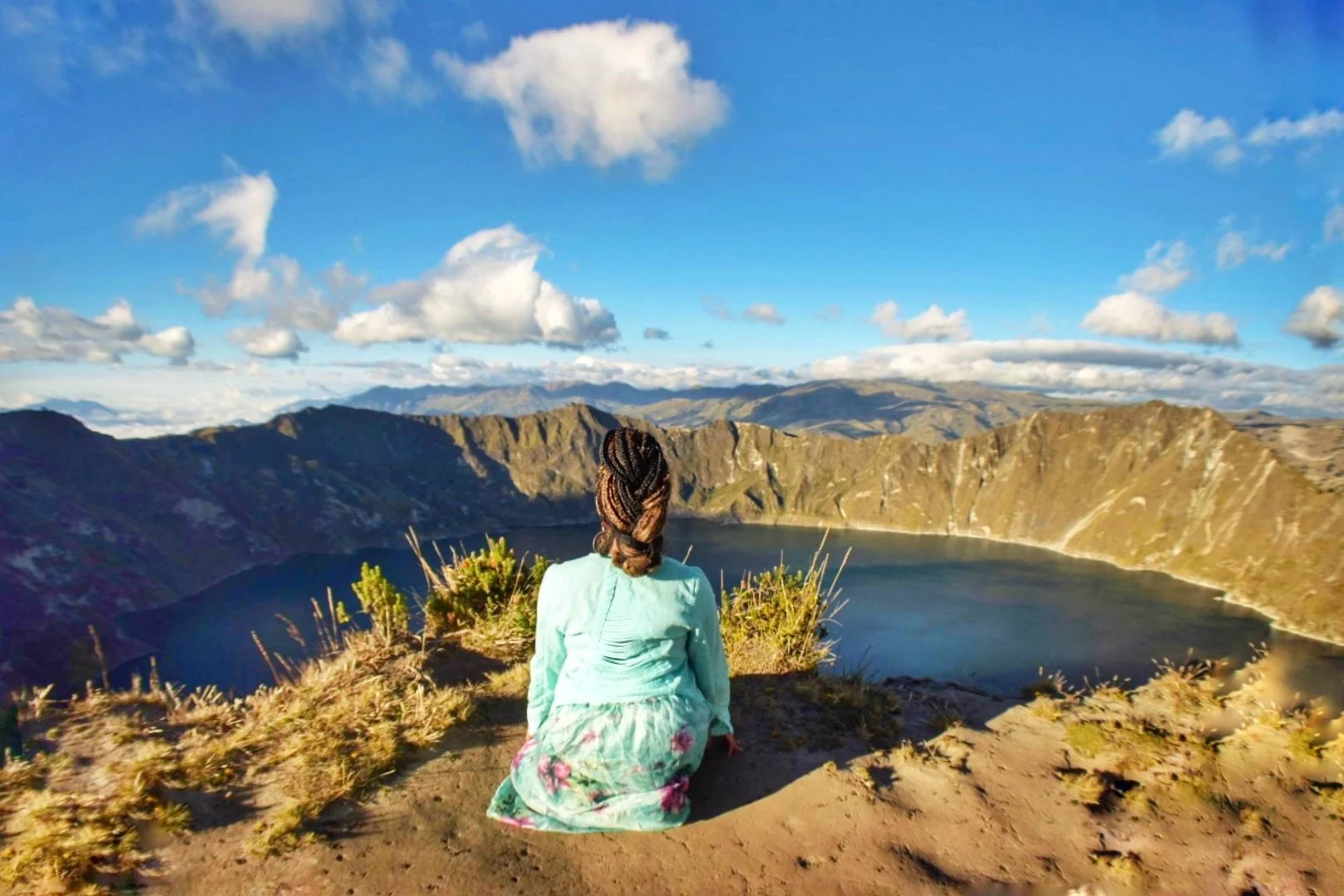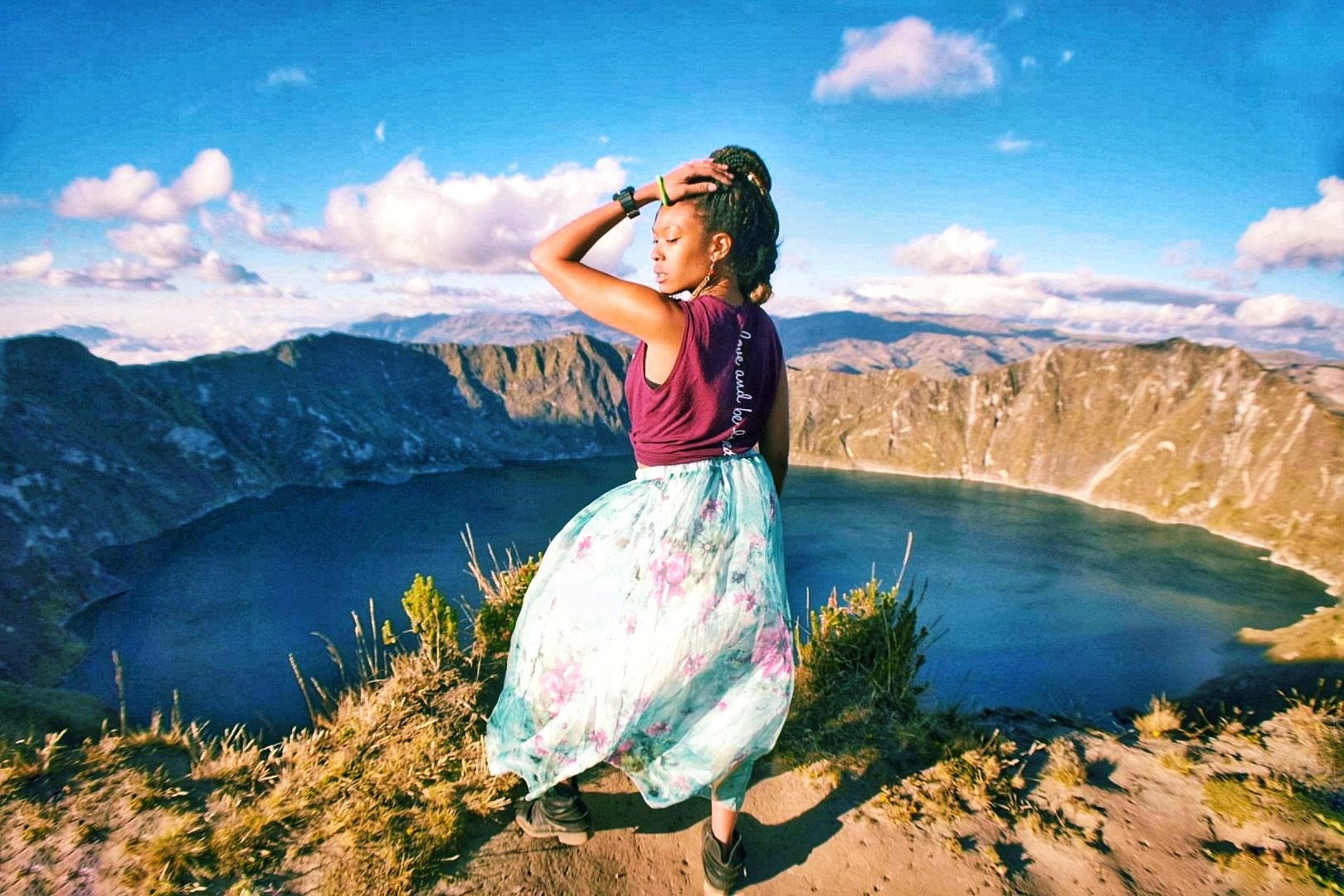Get lost in the Ecuadorian Andes when you find yourself at Lake Quilotoa, Ecuador’s famous crater lake. The lake is renowned for its vibrant, turquoise-tinted waters and scenic hiking trails, which include a tour of its three-kilometer-wide caldera rim. Located around 180 kilometers southwest of Quito, the nation's capital, the water-filled volcanic basin is reachable via public transportation.
Although the journey can be confusing for the uninitiated, this article will break down exactly how to get there and what to see and do while near Lake Quilotoa. If you want to get off the beaten path while traveling in Ecuador, visiting the volcanic lake should be at the top of your bucket list. It is also part of the Quilotoa Loop, a backpacking route that passes through several smaller towns scattered throughout the Andes along with the famed Ilinizas Reserve.
Besides trekking, there are plenty of other activities to do in the area, especially for backpackers and nature-lovers. From the best places to stay near Lake Quilotoa to the best restaurants around, this is your ultimate guide to Ecuador’s only crater lake.
The Legend
Currently, the most western volcano in the Ecuadorian Andes, Lake Quilotoa was formed around 800 years ago when an eruption caused its roof to collapse. The volcano had been dormant for nearly 14000 years before this Plinian eruption in 1280 resulted in a caldera (rim) whose diameter is more than 3 kilometers wide. The volcanic eruption was so violent that its lava flowed all the way to the Pacific Ocean more than 300 kilometers away.
Over the centuries, rainwater continued to collect in the lagoon, with around 0.35 cubic kilometers accumulating in its reservoir which has reached a depth of 250 meters (so swimming is definitely a big no-no). The blue-green-hued waters that Lake Quilotoa is famous for are generated by dissolved, volcanic minerals, and dangerous fumaroles also line the bottom of the lake. These subterranean vents release hot gases and toxic vapors which render the lake’s water rather acidic and contribute another reason as to why (again) swimming is prohibited.
Luckily, you can hike around the caldera, a journey which takes about 4-5 hours (around 10 kilometers) although watch for elevation sickness; the highest edge reaches nearly 4000 meters above sea level. The hiking route around the lake is quite sandy and steep in many places so it can be challenging, especially on windy or foggy days.
Withal, the lake and the quaint village that it’s named after have gained popularity with tourists, particularly as part of the Quilotoa Loop. This hiking trail is ideal even for novice hikers seeking to immerse themselves in the local natural beauty while exploring areas still inhabited by Quechua-speaking indigenous people. It’s also a common starting point for the Quilotoa Traverse, a multi-day hiking route (around 3-5 days) that passes through many Andean villages. If you’re a natural-born trekker, this is definitely an opportunity you can’t miss out on, but just give yourself enough time to acclimate as Quilotoa is about 1000 meters higher in sea level than Quito!
How to Get to Lake Quilotoa
For less than the price of a tank of gas, you can get to Laguna Quilotoa from Quito and back in a day. However, keep in mind that it will be an all-day journey so it might be better to break up the trip into separate sections rather than attempt to get there in one go (like I did). Whereas the drive in a hired car takes only around 3-4 hours, the public bus takes around the same amount of time for a fraction of the cost so travel at your preferred comfort level/budget.
Your best bet would be to plan an overnight trip and stay in either Quilotoa or in Latacunga, around 70 kilometers away. Zumbahua is the next closest town to Quilotoa, at around 17 kilometers away, and both towns offer direct connections to Quilotoa. The charming town of Quilotoa, the lake’s namesake, is located at its summit and you can expect most buses/trucks to leave you at the summit (the entrance to the town).
Still, the real magic lies in the crater below. Access to the town costs about the same as a cup of coffee (around $2USD) and is definitely worth the price of admission just for the viewpoint from the top.
From Quito to Quilotoa
You can catch a direct bus from Quito’s Quitumbe Bus Station (Terminal Terrestre de Quitumbe) to the south of the city which is operated by the bus company Las Illinizas (subject to availability). This bus typically leaves around 5PM daily and the fare costs around $3-5USD which can be paid at the ticket booth or paid directly to the driver.
Albeit, this option will obligate you to spend the night in either Quilotoa or a nearby town until the next day when there are buses that head back to Quito. The last bus to Quito from Quilotoa leaves well before nightfall yet the schedule is frequently subject to change depending on the season, so ask around town as early as possible the day you plan to leave.
If you prefer to make the entire journey in one day, your best option is to take the first bus out of Quito to Latacunga as early as possible and then connect from there. Plenty of bus companies run this route so you can price compare between the best ones like Cooperative Latacunga, Expreso Bolivariano, and Ciro Cotopaxi. You’ll have lots of options and the fare should only be around $3-5USD for the 2-hour trip.
From Latacunga to Quilotoa
If you don’t mind a stop-over, you can explore the idyllic town of Latacunga before continuing on to Lake Quilotoa. Buses leave nearly hourly from Latacunga’s bus station (Terminal Terrestre de Latacunga) until about late afternoon (before sunset) and are operated by bus companies such as Cooperative Viveros for $4-5USD. The trip takes around 2 hours while offering some incredible views of the Andean mountains and valleys.
Alternatively, if you miss the bus to Quilotoa, you have the option of taking the bus to Zumbahua and then hiring a taxi or pickup truck to transport you the rest of the way for around only $5-8USD. This route is also good to keep in mind in case you miss the return bus from Quilotoa to Latacunga since you can hire a car to take you from Quilotoa to Zumbahua to then catch the bus to Latacunga ($5-8USD).
Additionally, you can also hire private transportation to take you directly from Quilotoa to Latacunga (around $25-35USD), which might be well worth the splurge after a long day of hitting the hiking trails.
From Baños to Quilotoa
At around 150 kilometers away, the spa town of Baños de Agua Santa (Baños for short) is a good place from which to discover Lake Quilotoa if you’re already there. Nevertheless, there is no direct bus from Baños to Lake Quilotoa so you will have to transfer in Latacunga. Take the bus operated by companies like Expreso Baños from Baños Bus Station (Terminal Terrestre de Baños) to get to Latacunga to make the connection to Quilotoa. The first leg of the journey should take around 3 hours and costs around $3-5USD.
Where to Stay Near Lake Quilotoa
Quilotoa has grown by leaps and bounds thanks to a boom in tourism, and so too has its number of lodgings though don’t expect anything too extravagant. There are plenty of simple but comfortable accommodation options in town from hostels to hotels to home-stays offering both pack mules and tour guides. Some of the best places to stay in Quilotoa are:
Runa Wasi Quilotoa
This family-run pension is one of the most popular places to stay in Quilotoa and is located right in the heart of the town. The establishment offers family rooms with private bathrooms as well as free parking in case you’re arriving by car. It also features an on-site restaurant that serves guests both breakfast and dinner to make sure you keep your energy up throughout a long day of exploring.
Shalala Lodge
Situated on the periphery of the town, this community-run lodge offers its guests an amazing vantage point over Lake Quilotoa. While a bit pricier than other competitors in the area, its amenities more than makeup for the expense, such as free parking and pet-friendly facilities. They’re also the only accommodation to boast private cabins with private bathrooms and fireplaces while sleeping up to four people. Have breakfast at their on-site restaurant, which is one of the most popular in the area.
Samay Kirutoa Lodge
If you’re on holiday with a large travel party, this lodging is going to be your best bet since its largest suite houses up to four double beds plus a private bathroom. Located on the outskirts of Quilotoa (about 5 minutes walking to the center), the establishment provides its guests with a complimentary American-style breakfast every morning as well as the use of a garden to keep back in after a day full of adventure.
Martita’s House Hostal
This lively hostal has undoubtedly the best ambiance in town, providing its guests with a full range of facilities such as an on-site restaurant, a bar, a terrace, free parking as well as a 24-hour reception desk. The establishment can also help its guests with car rentals to better discover the surrounding area and provides them with free parking. Make sure to try their piping-hot complimentary breakfast.
Hosteria Chukirawa
Perched a mere 150 meters from Quilotoa’s bus station, this vibrant hostal is renowned for its décor and charming atmosphere. Backpackers can book a bed in a dorm while families can reserve a room for up to five people with an ensuite bathroom. Complimentary breakfast is served daily and free parking is available onsite. Book a free guided tour at their reception desk to make the most of their amenities.
Camping at Lake Quilotoa
At the bottom of the crater along the rim of the lake, camping is also permitted but I wouldn’t recommend trekking down with a ton of camping gear. While the hike down takes only about a half-hour, the way back can is rather steep and can take up to two hours since it’s close to a 280-meter vertical ascent. Moreover, there is no drinkable water near the lake so make sure to bring all you need to make the journey back and forth. Thankfully, there are restrooms available in the area.
BONUS TIP: If you decide to try the Quilotoa Loop, make sure to wear some sturdy hiking boots, waterproof gear, and plenty of drinking water. However, you won’t need to pack any camping equipment since there are many villages with hosterias along the trail. Just make sure to carry a printed map with you as some of the routers and signage can be confusing for beginners but you also have the option of renting a horse or a donkey to transport your gear.
Where to Eat Near Lake Quilotoa
While dining options in Quilotoa can be quite Spartan, there are a couple of restaurants that should definitely be on your radar even if you have certain dietary restrictions. Most are located within the town center just a stone’s throw away from one another so you won’t have to look too far for a place that’s right up your alley.
Karu Ñan Restaurante
One of the most well-known establishments in the area, this place shouldn’t be passed up if you’re craving authentic Ecuadorian cuisine. Boasting free WIFI for its guests, the restaurant is famous for its delicious dishes and warm atmosphere. Do yourself a favor and order their locro de papas soup to warm up on a chilly day.
Andean House Bar-Restaurante
Perched just 50 meters away from Lake Quilotoa, this cozy resto-bar is the perfect stop for a drink and a nibble. They serve everything from hot chocolate to pizzas and pasta to tasty empanadas while treating their guests to a laidback atmosphere and good music. Make sure to check out their extensive cocktail menu in case you need more of a night-time pick-me-up.
Restaurante Sinchy Tupak
The family-run eatery specializes in Ecuadorian cuisine and features a high balcony that offers an incredible view of Lake Quilotoa. The restaurant also sells eclectic handcrafts for travelers in search of souvenirs that are based on local folklore. Stop here if you want a meal with a view and a goodie-bag to go.
Final Thoughts
Lake Quilotoa is certainly a sight for sore eyes, especially if you’ve yet to tick visiting a crater lake off of your bucket list. Avid kayakers can rent a boat to take onto the lake to explore this aquamarine surface (3500 meters above sea level) up close for at least an hour. If you decide to go this route, make sure to avoid the active fumaroles that release toxic gases as well as the hot springs toward the east side of the lake. For the trek down to the lake, pack plenty of water and bring a jacket/coat as the site tends to be very windy year-round. During the rainy season, the use of a raincoat instead of an umbrella is highly advised, yet the best time to visit is between June and September when the weather is drier.
Travelers should keep in mind that Quilotoa is still an up-and-coming place so it doesn’t have all the amenities of its larger counterparts. There are not many local shops besides those selling local crafts and handmade goods as souvenirs so make sure to come with all provisions you may need from cosmetics to medicines. There are also no ATMs in town (at least not at the time of this writing) and most places don’t accept credit cards so cash is undeniably king.
If you have the time and love to hike, wandering along the Quilotoa Loop is a must as it’s undoubtedly the most authentic way to discover the centuries-old culture of the indigenous people. Support the local artists by straying from the beaten path and shopping for souvenirs at the various markets along the way as you traverse the same ancient paths walked by the Incas before the arrival of Spanish conquistadors changed the course of history forever.
May you get lost in the wonder,
M











